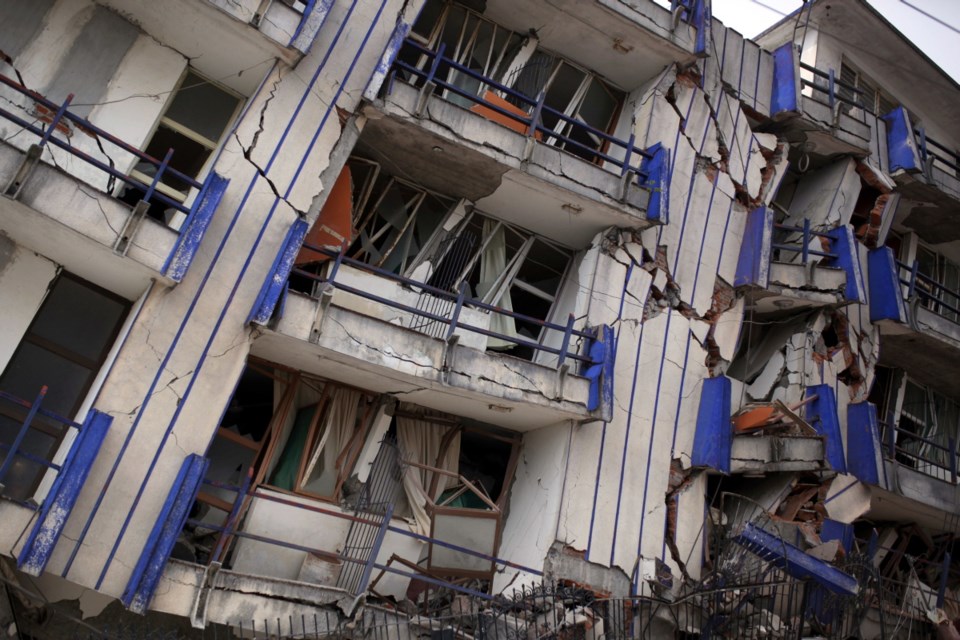A series of powerful earthquakes that struck Mexico this month have a lot to teach Vancouver Island about preparing for the Big One, experts say.
“We have a very similar situation here,” said John Cassidy, a Sidney-based seismologist with Natural Resources Canada. “Both of these earthquakes in Mexico involved ocean plates being pushed down. We have the same situation with tectonic plates about 45 kilometres below Victoria.”
Cassidy said Vancouver Island is a very active region for earthquakes, with dozens each year — most of which are not felt. Southwestern B.C. is located above the fault line where the Juan de Fuca plate is slowly pushing against the North American plate. When the plates suddenly shift or rupture, there is the potential for a megathrust earthquake and tsunami — though there’s no way to predict when that might happen.
“The important thing is to be prepared and know what to expect,” Cassidy said. That’s why his eyes are on Mexico.
A third strong earthquake shook the country on Saturday. The magnitude-6.1 temblor shook the state of Oaxaca, the region most battered by the first quake on Sept. 7.
At least one person was killed Saturday, bringing the total number of deaths from the quakes to more than 400.
It was among thousands of aftershocks recorded in the wake of that earlier quake, which at magnitude-8.1 was the most powerful to hit Mexico in 32 years and killed at least 96 people. The epicentre was 70 kilometres below ground.
“But then we have another major event 11 days later and only 650 kilometres away,” Cassidy said. “That is something we are looking at. What is the connection?”
The second quake, Tuesday’s magnitude-7.1 temblor, was centred near Mexico City and had a depth of about 51 kilometres. Heavy shaking lasted for 20 seconds.
Because the city has a public early warning system, many people were able to get out of buildings, but more than 300 people died. Dozens of structures crumbled.
Cassidy said footage and data of how the ground shook is important because, like various spots on the B.C. coast and Vancouver Island, Mexico City is on soft soil that amplifies the shaking.
“There are pockets of soft soil around Victoria, such as parts of James Bay where old creek beds were filled in,” he said, noting the City of Victoria has a series of maps showing which neighbourhoods are most susceptible to ground liquefaction and amplified shaking.
Cassidy said it’s important to recognize that the buildings in Victoria are very different from those in Mexico, due in part to B.C.’s stringent building code.
“And in Victoria, most of the buildings are wood-framed, which fare better in shaking than the older concrete buildings in Mexico,” he said.
Many B.C. buildings, homes and infrastructure have been designed or retrofitted with earthquakes in mind, Cassidy said, but there is still work to do. The province maintains a list of schools being retrofitted and at risk, with several on the Island deemed particularly dangerous. These include Victoria High School, Arbutus Middle School and Lambrick Park Secondary. B.C.’s legislature is also a vulnerable building.
The province does not have a public earthquake warning system like Mexico, but one is in the works — and it’s being built and tested in Victoria.
Ocean Networks Canada at the University of Victoria is in the process of installing an early warning system with a network of seismic sensors installed along the fault line and around the Island.
The project is a $5-million investment by the province. It was started last year and is set to be completed, tested and delivered to Emergency Management B.C. by March 2019.
“We already have some [sensors] delivering data,” said Teron Moore, a business analyst with ONC. The shoebox-sized sensors detect small vibrations that are the precursors to major shaking waves and send that information through fibre-optic cables to a data centre. From there, alerts can be sent out to emergency responders, services and, eventually, the public to prepare for the earthquake.
“This will mean gas lines can be shut off or a surgery can be stopped,” Moore said. Other applications could be triggering trains to slow down and hospital and fire bay doors to open, and prompting people to take cover.
“It could be as simple as coming down from a ladder or getting out of an elevator before it gets stuck,” he said. In Mexico, the push was to evacuate unsafe buildings, but given B.C.’s stronger structures, the message is to find cover from falling items indoors.
At this point, the early warning system can send alerts to some services on the Island such as fire departments, hospitals and gas utilities.
Moore said a public warning system should also come with public education, which is being credited as saving many lives in Mexico. Hours before the Sept.19 quake hit, there was a national preparedness drill in honour of another massive earthquake in the 1980s.
“I can’t help but look at Mexico and wonder: ‘Will we be prepared here?’ ” Moore said. “I do hope so. I think what we really need is education, training and a robust comprehensive system — which we don’t have at this point.”
— With a file from The Associated Press



